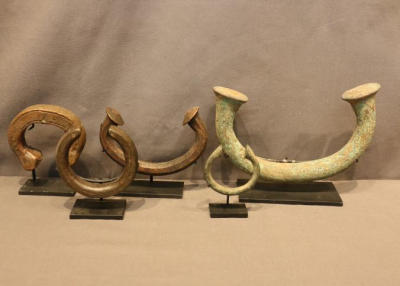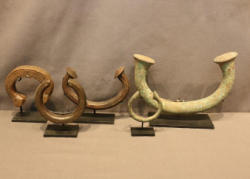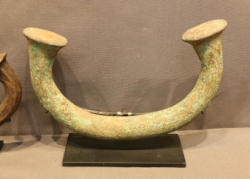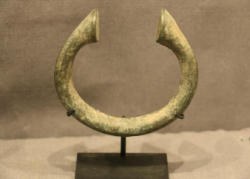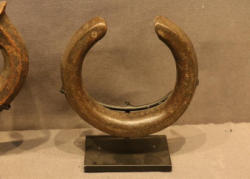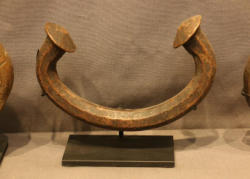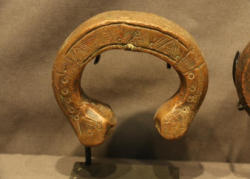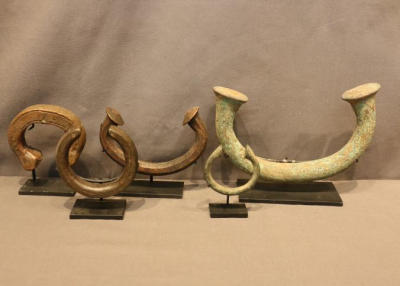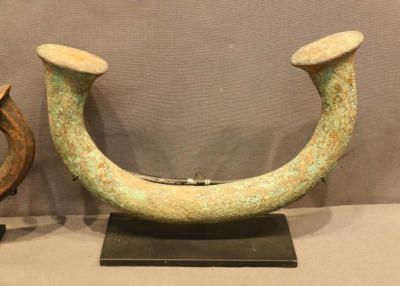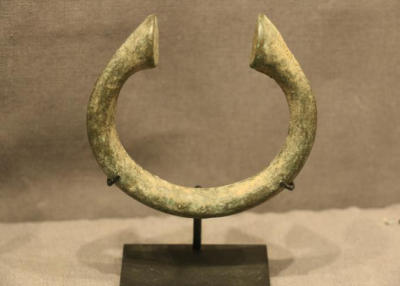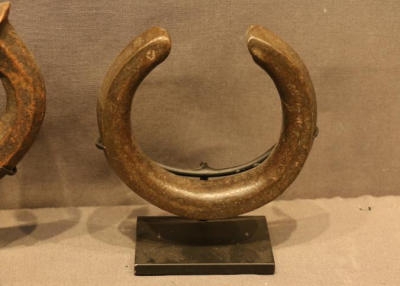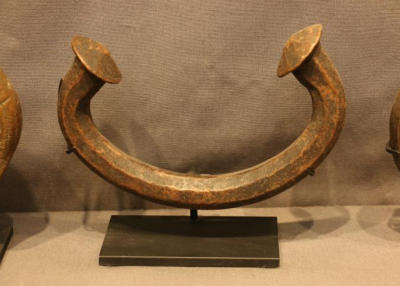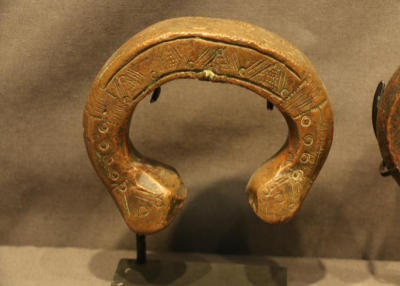Items located in Pleasant Valley, NY. Items include Faro, the water genie puppet from Mali; West African double gongs; Ode-lay society head crest mask from Sierra Leone; African sculptures, figurines, masks, textiles, ceremonial robes, copper rod currency, and more.
AFRICAN ART COLLECTION OF MARY SUE AND PAUL PETER ROSEN
Mary Sue and Paul Peter Rosen have collected African art for over thirty years, making nine trips to Africa to study the art in its cultural setting. The Rosens have published three African art books, curated more than ten exhibitions from their collection, and have given public lectures about African art and culture. They have donated art from their collection to various institutions including the Newark Museum, Temple University in Philadelphia, the SMA Fathers African Art Museum in Tenafly, New Jersey, and the African American Research Library in Fort Lauderdale, Florida.
Payment is due by Monday, April 1 at 1PM.
Pickup in Pleasant Valley, NY must be completed by Monday, April 1 at 3PM.
All lots sold as is, where is. There is a 15% Buyers Premium for all lots purchased. Payment methods include cash, MC, Visa, Discover or good check. You can make credit card payment online by going to your Member Area and selecting your invoice.
*NOTE* Shipping is available on all items.
AFRICAN ART COLLECTION OF MARY SUE AND PAUL PETER ROSEN
Mary Sue and Paul Peter Rosen have collected African art for over thirty years, making nine trips to Africa to study the art in its cultural setting. The Rosens have published three African art books, curated more than ten exhibitions from their collection, and have given public lectures about African art and culture. They have donated art from their collection to various institutions including the Newark Museum, Temple University in Philadelphia, the SMA Fathers African Art Museum in Tenafly, New Jersey, and the African American Research Library in Fort Lauderdale, Florida.
Payment is due by Monday, April 1 at 1PM.
Pickup in Pleasant Valley, NY must be completed by Monday, April 1 at 3PM.
All lots sold as is, where is. There is a 15% Buyers Premium for all lots purchased. Payment methods include cash, MC, Visa, Discover or good check. You can make credit card payment online by going to your Member Area and selecting your invoice.
*NOTE* Shipping is available on all items.
?EMBLEMS OF POWER. ASAFO FLAGS FROM GHANA? BY M.S. AND P.P. ROSEN IS ONLY AVAILABLE FROM THE AUTHORS AT ppr2001@med.cornell.edu PRICE POSTPAID IN US IS $25.00; OUTSIDE US POSTPAID $35.00.
Auction Info
Items located in Pleasant Valley, NY. Items include Faro, the water genie puppet from Mali; West African double gongs; Ode-lay society head crest mask from Sierra Leone; African sculptures, figurines, masks, textiles, ceremonial robes, copper rod currency, and more.
AFRICAN ART COLLECTION OF MARY SUE AND PAUL PETER ROSEN
Mary Sue and Paul Peter Rosen have collected African art for over thirty years, making nine trips to Africa to study the art in its cultural setting. The Rosens have published three African art books, curated more than ten exhibitions from their collection, and have given public lectures about African art and culture. They have donated art from their collection to various institutions including the Newark Museum, Temple University in Philadelphia, the SMA Fathers African Art Museum in Tenafly, New Jersey, and the African American Research Library in Fort Lauderdale, Florida.
Payment is due by Monday, April 1 at 1PM.
Pickup in Pleasant Valley, NY must be completed by Monday, April 1 at 3PM.
All lots sold as is, where is. There is a 15% Buyers Premium for all lots purchased. Payment methods include cash, MC, Visa, Discover or good check. You can make credit card payment online by going to your Member Area and selecting your invoice.
*NOTE* Shipping is available on all items.
AFRICAN ART COLLECTION OF MARY SUE AND PAUL PETER ROSEN
Mary Sue and Paul Peter Rosen have collected African art for over thirty years, making nine trips to Africa to study the art in its cultural setting. The Rosens have published three African art books, curated more than ten exhibitions from their collection, and have given public lectures about African art and culture. They have donated art from their collection to various institutions including the Newark Museum, Temple University in Philadelphia, the SMA Fathers African Art Museum in Tenafly, New Jersey, and the African American Research Library in Fort Lauderdale, Florida.
Payment is due by Monday, April 1 at 1PM.
Pickup in Pleasant Valley, NY must be completed by Monday, April 1 at 3PM.
All lots sold as is, where is. There is a 15% Buyers Premium for all lots purchased. Payment methods include cash, MC, Visa, Discover or good check. You can make credit card payment online by going to your Member Area and selecting your invoice.
*NOTE* Shipping is available on all items.
?EMBLEMS OF POWER. ASAFO FLAGS FROM GHANA? BY M.S. AND P.P. ROSEN IS ONLY AVAILABLE FROM THE AUTHORS AT ppr2001@med.cornell.edu PRICE POSTPAID IN US IS $25.00; OUTSIDE US POSTPAID $35.00.
Categories:
Previous
|
FIVE EXAMPLES OF WEST AFRICAN MANILLA CURRENCY. Manillas are a diverse group of iron, copper, and brass forms of African currency. Origin of the term manilla has been attributed to manilho or manillio, said to refer to bracelet in Portuguese and Spanish. Manillas have semi-circular C-shapes, U- or elongated U-shapes, as well as ring and coiled forms. The majority of manillas used in Africa were of European origin, but some were also produced by Africans, especially in the Congo. The major European sources of manillas were the Portuguese, the English who brought Birmingham manillas, the French who brought “popo” manillas cast in Nantes, and the Dutch with manillas made in Amsterdam. Manillas were accepted by Africans in trade for a vast variety of goods which Europeans shipped back to their countries, including slaves. Manillas were also used as currency by Africans in major transactions such as bride price, as prestige items (often placed in tombs) , and as a store of wealth which frequently was hidden and buried. Each on custom base. (A) French C-form “popo” manilla from Nantes. Copper alloy. H 3in. Width 3.5in. (B) Extended U-form “queen” faceted manilla with flared ends called “onganda” or “onglese”. Collected in Congo. H 4.5in. Width 7.5in. Weight 1.6lb. (C)English C-form faceted manilla . Collected in Nigeria. Copper alloy. H 4in. Width 4.5in. (D) Bracelet-form manilla with flared ends cast by Hausa blacksmith. Surfaces covered with punched designs that are partly effaced by wear. Dates from 1800s. Copper. Collected in Niger. H 4in. Width 4.5in. Weight 2.6lb. (E) English round, extended-U “king” manilla with flared ends and extensive surface designs partly obscured by oxidation after having been buried and excavated in Nigeria. Dated early 1800s. Copper alloy. H 5.5in. Width 10in. Weight 9lb.
More Details
FIVE EXAMPLES OF WEST AFRICAN MANILLA CURRENCY. Manillas are a diverse group of iron, copper, and brass forms of African currency. Origin of the term manilla has been attributed to manilho or manillio, said to refer to bracelet in Portuguese and Spanish. Manillas have semi-circular C-shapes, U- or elongated U-shapes, as well as ring and coiled forms. The majority of manillas used in Africa were of European origin, but some were also produced by Africans, especially in the Congo. The major European sources of manillas were the Portuguese, the English who brought Birmingham manillas, the French who brought “popo” manillas cast in Nantes, and the Dutch with manillas made in Amsterdam. Manillas were accepted by Africans in trade for a vast variety of goods which Europeans shipped back to their countries, including slaves. Manillas were also used as currency by Africans in major transactions such as bride price, as prestige items (often placed in tombs) , and as a store of wealth which frequently was hidden and buried. Each on custom base. (A) French C-form “popo” manilla from Nantes. Copper alloy. H 3in. Width 3.5in. (B) Extended U-form “queen” faceted manilla with flared ends called “onganda” or “onglese”. Collected in Congo. H 4.5in. Width 7.5in. Weight 1.6lb. (C)English C-form faceted manilla . Collected in Nigeria. Copper alloy. H 4in. Width 4.5in. (D) Bracelet-form manilla with flared ends cast by Hausa blacksmith. Surfaces covered with punched designs that are partly effaced by wear. Dates from 1800s. Copper. Collected in Niger. H 4in. Width 4.5in. Weight 2.6lb. (E) English round, extended-U “king” manilla with flared ends and extensive surface designs partly obscured by oxidation after having been buried and excavated in Nigeria. Dated early 1800s. Copper alloy. H 5.5in. Width 10in. Weight 9lb.
High Bid:
$80.00 – guyro
Auction Type: One Lot
Quantity: 1
Bidding has closed on this lot

